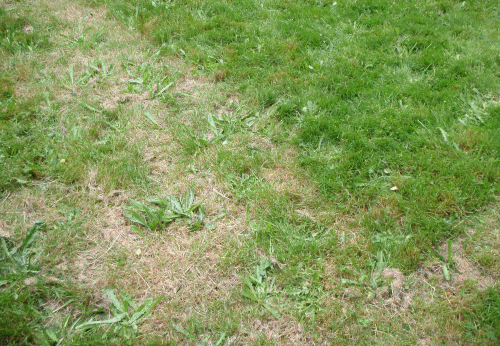posted 5 years ago
I’m glad I found this post and I think it is time to resurrect it again. I too have a lawn, a wide boulevard next to a school and beyond that a high rise condo building, that I wish to make more interesting! Hell, I wish to make it survive! But why not think big – I would like it to flourish, even thru the worst drought, either staying green or flowering or both, all without any watering or fertilizer. And it may as well be a pollinator lawn as well as an eco lawn to cover as many bases as possible. Since it is trampled daily by a horde of students, bicycles, dog walkers, and their “out for a bathroom break” dogs, I’m not adding a food/medicine option to my wish list. Oh and just to make it harder, it has to grow in full sun, between pavement and concrete, on thin, poor soil with nothing but pure sand underneath…..
So, to take the traffic and not be a mud bath during cold rainy early springs, and to look like a lawn, it has to start with grass. So many tenacious weeds which could be or are O.K. nevertheless die off at the first frost and don’t re-emerge ‘till the following May. This next growing season will be my third since I conceived of this vision and I have already learned quite a few things….
To begin with, I have replaced the 8 inch wheels of my mower with 10 inch wheels so I can mow the grass higher. This allows more flowers to bloom and the grass to better survive summer drought. I’m now starting in the spring before the first mow at 2.5 inches high, then with the rapid spring growth cutting at 3 inches high. I gradually increase the height to a maximum of 5 inches in the summer drought and then come back down all the way to 2.5 inches by frost, mulching a ton of maple leaves from elsewhere on my property into this boulevard.
Best plant by far to stay green in summer drought and have the best yellow flowers is birdseye trefoil! But it has 2 drawbacks. It is VERY slow to establish. I started this stuff 2 years before I even thought of this ecolawn idea because it was the ONLY thing alive in any boulevard lawns on my street during a drought. There is a saying, “the first year it sleeps, the second year it creeps, and the third year it leaps!” Also, it cannot be transplanted. It needs seeds on bare ground. To produce more seed and to enjoy its massive yellow flowers by the 4th summer I mowed around patches of it until it was done seeding. By the 5th summer I had to mow it back to keep it from choking out the grass underneath. This became a pattern for lots of other weeds/flowers. Mow around them to get them established, then mow normal to maintain them, or even mow lower over them to let the grass keep up. Because the second problem; they die right back with the frost and then you need that grass to still be there.
Most weeds/flowers have this problem of winter die-back even if they are perennial so plants that stay alive/green or at least present year round like grass are premium for me. One good one is heal-all. It is very hardy, drought resistant, and has reasonably nice purple flowers. It is not always green, spending much of the year a purplish colour.
I have lots of white clover and red clover. Although they are considered drought resistant, they are in no way as good as birdseye trefoil in that regard. Otherwise they are quite similar to the trefoil, including all of them getting nitrogen from the air and adding it to the lawn, and also dying off in the winter. I have a little sweet yellow clover but haven’t learned much about it yet – it arrived on its own last year. Black Medic which some people call yellow clover is removed from my lawn. Yes it looks nice; green with yellow flowers. BUT, it dies and turns to seed at the exact same time the grass dies or goes dormant from drought. Thus it has bare soil for its own seeds and grows back a hundred fold, outcompeting the grass.
I’ll list some more of my favourites in another post….

 2
2

































 2
2














 6
6




 4
4















 3
3




 2
2




 3
3




 1
1




 1
1




 1
1

























 2
2
















 1
1




 1
1








 1
1




 2
2







